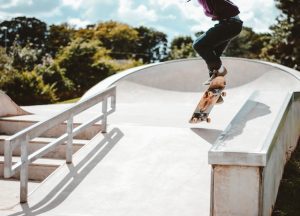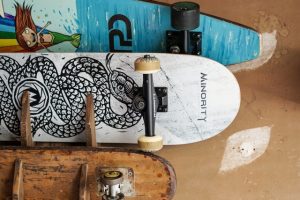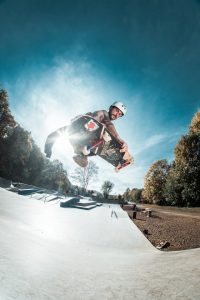Beginner’s skateboarding trick variation. Catch our top trick list in this article.

Wanna learn a skateboarding trick, like backflipping skateboarding on the ramp, doing an ollie skateboarding trick, or a frontside pop-shove-it skateboarding trick? Different variations exist, which can be experienced both by beginner and expert riders. A skateboard trick list would come in handy when you practice. With this list, skateboarding enthusiasts often practice the ollie to master tricks like grinds and drops with style.
Welcome to the exciting world of skateboard riding! We help you understand varied skate tricks. This article’ll explore the exciting world of skateboard trick variation. Name it – intermediate tricks, basic tricks, grind tricks, flip tricks, and more! From skate ollies and pop shuvits to heel flips and kickflips, we’ll discuss the basics and offer insights from a basic skateboard trick list that will challenge even seasoned riders. We’ll also provide helpful tips on choosing the right gear, maintaining safety, and mastering the techniques required to pull off these tricks.
Our aim is to help you maintain steady progress in this exhilarating sport while serving as a valuable resource in your riding journey. So grab your board and let’s get rolling – it’s time to spice up your repertoire!
Key Takeaways
At FamilyHype, we understand the importance of learning the fundamentals of skateboard riding from the skateboard trick list and the need to evolve in this thrilling sport continuously. Exploring different ways to perform stunts offers endless opportunities to add excitement and creativity to our rides. With the right gear and mindset, we can all master these stunts – ollies, kickflips, heelflips, shove-its, and 180s being just a few of the more popular varieties.
Let the riders keep pushing their limits and exploring new possibilities while riding the board. We hope our skateboard trick list will help you master all the tricks.
Skateboarding Tricks
Basic
Riders often spend time honing fundamental skills before progressing to intermediate or advanced tricks like a rock-to-fakie on transition ramps, advanced tricks with one foot, or a backslide boardslide. Mastering the basics of the board is crucial to building a strong skateboard riding foundation. Key skills include riding techniques, ollies, kick turns, tail and nose stalls, powerslides, shove-its, manuals, and basic grind and slide tricks.

Mastering the pop shove-it is crucial in maneuvering your board too. This foundational stunt enhances board control and coordination, making it an essential skill all skaters should possess. As riders progress, they can explore varieties like the frontside pop shove-it, backside pop shove-it, varial pop shove-it, big spin pop shove-it, and even the challenging 360 pop shove-it. These varieties expand a rider’s repertoire and serve as stepping stones to more advanced stunts, highlighting the frontside pop shove-it’s pivotal role in skateboard riding progression.
As skaters advance, they can explore more complex tricks and flip varieties. These foundational skills not only improve board control but also provide a solid base for learning more advanced maneuvers in the dynamic world of skateboard riding.
Finally, mastering a basic skateboard tricks list requires an understanding of skatepark etiquette. This involves respecting other skaters’ space and not doing the stunts in unsafe areas. Being aware of your surroundings and paying attention to fellow riders is also essential. With this understanding, we can all enjoy the thrilling world of skateboard riding and make it a safe and enjoyable experience for everyone.
Flip & Slide
Skateboard riding is all about pushing the boundaries of what’s possible on a board, and stunt variations significantly showcase creativity and style. Flips grinds, and slide tricks are some of the fundamental elements that add a kaleidoscope of uniqueness to the sport.
Flips, like kickflips and heelflips, involve spinning the board in the air, adding a flair of technical skill to the rider’s repertoire. Grinds, such as board slides (for grind and slide tricks) and 50-50s, involve sliding along the railings or edges of obstacles, displaying a skater’s ability to precisely balance and control the board.
Slides, like powerslides and tailslides, add a touch of finesse to a rider’s moves, allowing them to maneuver and slide the board while maintaining control. Combining these tricks with various stances, like switch and fakie, enhances the complexity and uniqueness of a rider’s performance.
To be honest, there are a lot of tricks you can practice. Some, like the Butter Flip, are where the rider puts pressure onto the end of the board while they use the foot that is not on the wheel. Another one named the Finger Flip is where the rider rolls forward and puts their fingers on the nose of the board then they jump and flip the board with their hand. All of this happens mid air.
Another trick, as seen in the earlier Powell Videos, is the No-Comply, Step-Hop, No Handed Boneless. The front foot slides off the side of the board, with the rider’s body weight on the back foot near the tail and guided by the back leg or knee. The rider jumps with their front foot in order to ride away. This was typically used by street skaters in the mid to late 80s.
Skateboard riding culture embraces stunt creativity, encouraging skaters to develop their signature moves and take board riding to new heights. Whether at a local skatepark or in the streets, showcasing awe-inspiring performances stands out and fosters camaraderie within the skateboard riding community. So, as you embark on your journey with your board, let your creativity shine and explore the vast array of flip tricks that make the sport so exhilarating and dynamic.
Equipment
- We must pay close attention to the skating equipment we use. First and foremost, it’s important to choose the right skate because it affects skate flip tricks.
- Consider the size of skates. For instance, cruisers are a type of skateboard with large soft wheels that are perfect for cruising around town. Mini-longboards are a type of skateboard designed to emphasize agility and quick turning. And lastly, street skateboards cater to performing stunts and jumps.
- These types of boards can also come with different deck sizes and shapes. Decks can vary in width, typically ranging from 7.5 to 8.5 inches, and they may feature distinct shapes tailored to various styles. The skates may also come with different wheel sizes, ranging from 50mm to 70mm. All these factors contribute to the overall experience of the ride and should be considered when selecting a board.
- Aside from the safety skate gear, you should also have some accessories with you. For example, the grip tape – this tool is important to have in many stunts. It can be used in the simplest of stunts like the skate Ollie to other complex ones. The keys to a good freestyle contest run rely not only on the right styles but also on the right skateboard.
Right Skateboard For Skateboard Tricks Variation
When choosing the right skateboard, there are a few key factors to consider from the skateboard trick list. The most crucial component is the deck. Skateboard decks come in various shapes, sizes, and materials, each catering to different styles of skateboard riding.

For trick varieties, a deck with a medium concave and a size that suits your height and shoe size is ideal. The concave refers to the deck’s curve, which helps with board control during stunts. A medium concave strikes a balance between stability and maneuverability.
Next, consider the trucks. Trucks are the metal T-shaped components that attach the wheels to the deck. For trick varieties, medium or standard-sized trucks are suitable, as they offer a good combination of stability and responsiveness.
Wheels and bearings are also essential to enhance stunt performance. Smaller and harder wheels provide faster speeds and better control for technical flip tricks while larger and softer wheels provide a smoother ride, especially when cruising and transitioning.
Safety For Skateboard Tricks Variation
Before you jump on your board, always wear your protective gear. Safety gear is non-negotiable. Protecting yourself from potential injuries is crucial, especially when attempting more complex and technical maneuvers.
- Skate Helmet: Always wear a certified skateboard helmet that fits properly and securely. Helmets protect your head from serious injuries in case of falls or accidents.
- Skate Knee Pads and Elbow Pads protect your joints from impact and abrasions during falls or slides. Choose pads that provide sufficient coverage and have a comfortable fit.
- Skate Wrist Guards: Wrist guards help prevent wrist injuries and joints in skateboard riding when breaking falls. Look for wrist guards with strong support and padding.
- Skate Shoes: Wearing durable skateboard riding shoes with good grip is essential for controlling your board during flip tricks.
- Skate Clothing: Wear comfortable and appropriate clothing that allows for ease of movement. Avoid loose clothing that may get caught in the skateboard or hinder your balance.
When attempting new flip tricks, tricks like nollie or frontside pop shove it, or pushing the boundaries of your skills, it’s normal to experience falls or mishaps. Safety gear can significantly reduce the risk of injuries and allow you to focus on honing your skills confidently.
Remember, skateboarding is all about pushing yourself and having fun, but doing so responsibly and safely is crucial. By choosing the right board and wearing the necessary safety gear, you’ll be well-equipped to explore the world of skateboard trick varieties with excitement and peace of mind.
Tips
- Mastering trick varieties requires attention to equipment and safety. Choosing the right board and wearing essential safety gear is crucial for performance and injury prevention.
- To excel in executing stunts, focus on mastering basic skills, progress gradually, learn proper frontside pop shove techniques, and practice consistently. Seek guidance from experienced skaters, visualize success, and embrace fear and failure as learning opportunities.
- Push your limits, record your progress, and prioritize safety while having fun exploring the world of skateboard stunts.

Advanced Tricks
Advanced skateboard trick varieties take the sport to a new level of creativity and technical skill. Skaters who have mastered the basics can challenge themselves with complex maneuvers that push the boundaries of what’s possible on a board. Some popular advanced trick varieties include:
- Kickflip Variations And Pop Shove It: Skaters can add variations to the classic kickflip, such as double kickflip, inward heelflip, and varial kickflip, where the board spins in different directions while flipping. Additionally, mastering the front foot pop shove-it is crucial in maneuvering your board too.
- Grinds and Slides: Advanced skaters can perform various grind and slides on rails and ledges including pop shove it, like 50-50 grind, nose grind, smith grind, crooked grind, and feeble grind.
- Flips and Spins: Flip tricks like 360 flip, pressure flip, hardflip, 540 spin, varial heelflip, and big spin combine flips and spins for impressive aerial maneuvers.
- Manuals and Nose Manual: Advanced skaters can maintain wheelie-like positions on the back or front wheels for extended distances, adding style and control to their riding.
- Lip Tricks: Skaters can explore lip tricks on quarterpipes and halfpipes, side tricks and basic tricks, like backside and frontside airs, tailslides, disasters, and body varials.
- Gap Tricks: Skaters can do flip tricks ollie or flip over gaps, or pop shove it on the stairs, and obstacles, pushing their skills to navigate challenging terrain.
- Handplants: Advanced skaters can execute handplant tricks, side tricks, and basic tricks, like Andrecht grabs and lien to tail grabs, combining aerial flips and spins with hand touches on the ramp coping.
- Flip-In and Flip-Out Tricks: Skaters can add flips into and out of grinds, slides, and manuals, showcasing a high level of technicality and precision.
- No-Comply Tricks: No-comply variations, like no-comply 180s and big spins, involve footwork and board manipulation for creative flat-ground tricks.
- Big Air Tricks: Skaters can attempt huge airs and spins over vert ramps and mega ramps, showcasing extreme heights and difficulty.
A good skateboarder must progress gradually, ensuring they have the necessary skill, control, and safety gear before attempting advanced varieties of stunts such as pop shove it. This requires dedication, practice, and a fearless spirit to achieve awe-inspiring performances on the board. Skate games on the ramp are fun
From basic tricks, grind stunts can be harder for even the average skater. Practicing any skating trick involves time and effort, especially when mastering grind and slide tricks, basic tricks, side tricks, and more. We also can’t deny the danger involved when one is not careful. They can fall and drop and get many injuries. So always check your surroundings and be on top. Prevention is always better than cure.
Skateboard Trick Variation
Keeping track of your progress in skateboard riding can be a game-changer in improving and refining your skills. Here at FamilyHype, we highly value the family unit and are committed to helping you reach your goals.
It’s crucial for technique refinement, helping us identify areas needing work. We’ve found that using tools for progress tracking motivates and keeps us on a continuous improvement path.
This sport requires focus, discipline, and a commitment to improving your skills. With the right tools, riders of all levels can track their progress and improve steadily. This includes tracking metrics such as the number of skateboard tricks landed, the number of hours spent skating, and the amount of time spent practicing specific stunts. From a stationary position to numerous rocket air tricks and leg tracing throughout the stunts, you will need a lot of time to get used to these.
Monitoring your progress can help you identify areas for improvement and adjust your practice routine. In serving others, we promote this practice as an effective way to maintain and boost our skateboard riding prowess. The main thing to focus on is that you stay consistent, create a list of tricks you want to master, and do your best.
We hope that by sharing our insights, we can help you stay on track and reach new heights with your skateboard riding skills. Please share your feedback and experiences to help us better serve you.
Skating Trick
In conclusion, mastering impressive skate tricks variations like skateboard tricks where the rider flips, frontside pops, backside pop shove-its, and more showcases years of experience and skill development beyond the realm of basic tricks. These additions to a skater’s trick list testify to their expertise, especially when executed flawlessly on flat ground. Skateboarding offers easy and complicated tricks so you can constantly improve yourself. Be it at home or on the ramp, you will get the chance to improve your skills.
Skateboard riding is all about creativity and pushing boundaries. Choose the right gear, wear safety equipment, and practice consistently. For advanced skaters, explore many stunt variations to showcase your skills. Many other skateboard tricks are easy to perform once you’ve mastered the basics.
Remember, skateboard riding is not just a sport; it’s a way of life. Embrace the thrill, be part of the community, and keep pushing yourself. Keep rolling and shredding – the possibilities are endless!
We hope you’ve enjoyed every step we made in our top list, such as learning the nollie conquering various skate games on the ramp and making a land with style.
Varied Skate Tricks
Frequently Asked Questions (FAQs):
What’s The Hardest Skateboard Tricks Variation?
The difficulty of skateboard tricks varies from skater to skater, but some of the hardest tricks in skateboard riding include the 900 (2.5 spins), the triple heelflip, and various technical flip-in and flip-out skateboard tricks. In this culture, you have to be ready with numerous falls as you perfect the many stunts. It’s not like the movies where you easily learn a new stunt.
How To Do A Laser Flip?
A laser flip combines a late backside 180 body varial, pop shove it, and a heelflip. The skater initiates the flip and spins simultaneously, creating a unique trick. If you’re having trouble on your own, you can check a blog or video.
What’s A Hospital Flip Skateboard Trick Variation?
A hospital flip, a “tossed salad,” is an unusual trick where the skateboard flips and spins unpredictably. This is a half-kickflip that turns into a Casper spin-around. The rider initiates by performing a kickflip on one’s board but stalls the rotation at the halfway point; then the other foot in front executes an upward flick which will cause the board to spin at 180 degrees.
Is There A Skateboard Trick Variation Called Impossible?
Yes, the “impossible” is a famous skateboard trick. It involves using the back foot to flip the board 360 degrees without any contact from the front foot. There is also an easier version, called the Half Impossible, also known as the Pressure Shove It/Halfpossible – this freestyle skateboarding trick is usually done by popping the tail. Another one is the Ollie Impossible, which is performed into a nose/switch Casper.
Is a 360 Hardflip a laser flip?
No, a 360 hard flip is not a laser flip. A 360 hard flip involves a 360-degree shuvit and a kickflip, while a laser flip combines a late backside 180 body varial with a heelflip.
How To Do A 360 Hardflip?
To perform a 360 hardflip, pop the tail and flick the board diagonally, initiating the 360 shuvits and the kickflip simultaneously. Another complex one is the Godzilla Flip. This trick involves standing with one foot on the board in tailstop, then spinning the board in an Impossible around that same foot with a hand.
How Do You Do A Lazy Tre Flip?
A lazy tre flip is a laid-back version of the 360 flips. It requires a subtle flick and spin, allowing the board to flip more relaxedly. Practice finding the right balance of control and flip to achieve a lazy tre flip.
What Is A 180 Tre Flip Called?
A 180 tre flip is commonly known as a “switch 360 kickflip” or “360 pop shuvit kickflip.” It involves spinning the board 180 degrees while simultaneously performing a kickflip.
What Is A Dolphin Flip?
A dolphin flip, also known as a “forward flip” or “underflip,” is a trick where the skater kicks the tail of the board down, causing it to flip vertically beneath their feet. The rider grabs the nose and it causes the board to rate to almost 180 degrees towards the front, between the front leg and back, so that it lands wheels down.
What Is A Gazelle Flip?
A gazelle flip is a combination of a 360 kickflip and a late backside 180 body varial. The skateboard performs a 360 flip while the skater simultaneously rotates their body 180 degrees in the opposite direction.
Last Updated on July 4, 2024 by Lisette Lao
DISCLAIMER (IMPORTANT): This information (including all text, images, audio, or other formats on FamilyHype.com) is not intended to be a substitute for informed professional advice, diagnosis, endorsement or treatment. You should not take any action or avoid taking action without consulting a qualified professional. Always seek the advice of your physician or other qualified health provider with any questions about medical conditions. Do not disregard professional medical advice or delay seeking advice or treatment because of something you have read here a FamilyHype.com.